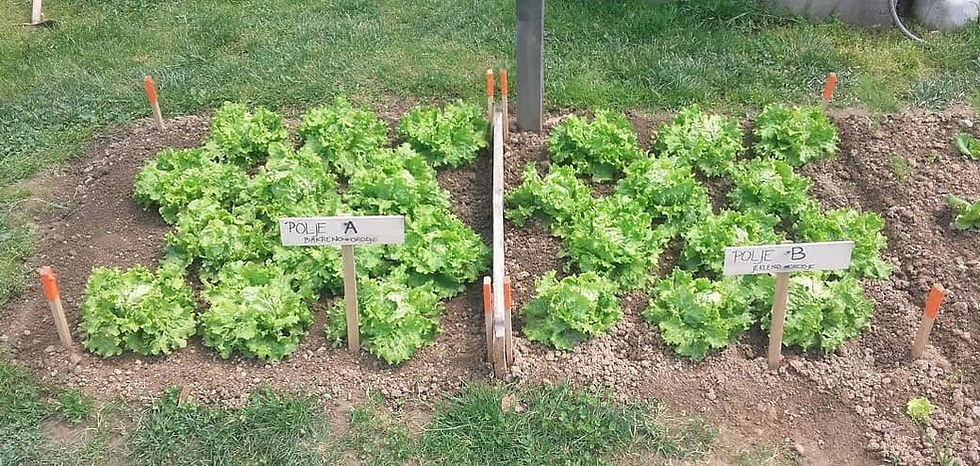The Science of Copper Garden Tools
- ostijarej
- Jul 28
- 3 min read
Exploring how copper tools influence soil, plant vitality, and sustainability.
Introduction: Rethinking Garden Tools
Garden tools are usually made of steel or iron. But what if the material of your hoe, rake, or trowel could directly affect your soil and plant health? In recent years, more gardeners and farmers have turned to copper tools – not just for their beauty or resistance to rust, but for their potential biological and energetic benefits to the earth.
This post dives into scientific observations, traditional knowledge, and experimental results, including those from Austrian researcher Viktor Schauberger and a Slovenian university study, to understand what makes copper garden tools so special.
1. What Happens When You Use Copper in Soil?
Unlike copper-based sprays or fungicides, copper tools do not add concentrated chemical compounds to the soil. Instead, through friction and contact, trace amounts of copper ions (Cu⁺ and Cu²⁺) gradually dissolve into the soil, especially when humidity is present.
These trace copper ions:
support enzyme activity in plants,
help in the formation of cell walls and lignin,
play a role in photosynthesis and reproduction,
contribute to plant immunity and water metabolism.
Important note: These are not “doses” of copper, but gentle, continuous micro-interactions as tools glide through the soil.
2. University Study: Real-World Experiment in Slovenia
In 2017, Anja Berber at the University of Maribor conducted a diploma thesis under the mentorship of Dr. Ana Vovk Korže to compare two soil plots:
Plot A: worked weekly with copper tools
Plot B: worked with standard steel tools
Measured over 4 months (Feb–May), results showed:
Soil Property | Copper Tools (Plot A) | Steel Tools (Plot B) |
pH Level | Higher (less acidic) | Lower (more acidic) |
Water retention | Significantly better | More moisture loss |
Potassium (K) | Higher | Lower |
Structure | More crumbly, fine aggregates | Coarser, compact structure |
Life in soil | More earthworms and insects | Fewer soil organisms |
No significant differences in nitrogen or phosphorus levels were observed. Visual observation of lettuce plants showed better growth and vitality in Plot A.
3. Viktor Schauberger’s Observations: Energy & Soil Harmony
Austrian naturalist Viktor Schauberger was one of the earliest advocates for copper tools in agriculture (1930s–1940s). Based on his deep study of natural flows and soil vitality, he proposed that:
Iron tools disrupt soil magnetism, dry the earth, and attract pests.
Copper tools preserve soil moisture and natural energy flows.
Plants in copper-treated soil grew larger, stronger, and more resistant to disease and pests.
Fields plowed with copper had fewer slugs and less fungal damage.
Though his work was dismissed by mainstream agriculture at the time, modern findings increasingly echo his early insights.
4. Other Reported Benefits by Gardeners
While more scientific validation is needed, users of copper garden tools often report:
Reduced slug activity (possibly due to copper’s electric properties and soil pH modulation)
Better soil texture and oxygenation
No rust or sparking, and longer tool life
Less soil sticking to blades – tools stay cleaner and more efficient
Gentler soil disruption = faster healing of soil structure
5. What Copper Tools Are NOT
Copper tools do not replace proper soil management. They:
Don’t inject copper sulfates or industrial chemicals
Don’t work instantly – effects are cumulative
Don’t eliminate the need for compost, mulch, or organic matter
Also, most copper tools are actually made of bronze (an alloy of copper and tin), which is harder and more durable, but still releases beneficial copper ions.
6. Looking Forward: More Research Needed
The Slovenian study recommends long-term monitoring, especially on:
Microbiological soil activity
Root development
Slug population dynamics
Interactions with biodynamic or permaculture methods
As awareness grows and ecological agriculture evolves, copper tools may become a quiet revolution beneath our feet.
Conclusion: A Tool with Intelligence?
Perhaps copper tools are more than just implements — maybe they’re a bridge between us and nature. By working with copper, we’re not just shaping soil; we’re co-creating with its living intelligence.
Next time you dig in the garden, ask yourself:What story is your tool telling the earth?
📎 References & Further Reading
Berber, A. (2017). Vpliv uporabe bakrenega orodja na lastnosti prsti. University of Maribor.
Schauberger, V. (1940s). Experiments and writings on soil energy and copper ploughs.
Cobbald, E. (2009). Earth Matters.
Harland, B. (2014). On the Utility of Copper Garden Tools.
Švigelj, A. (2015). Naravno vrtnarjenje.
Svete, M. (2014). Baker in naravni procesi.
Shorrocks & Alloway (1988). Copper in Soil and Plants.




Comments